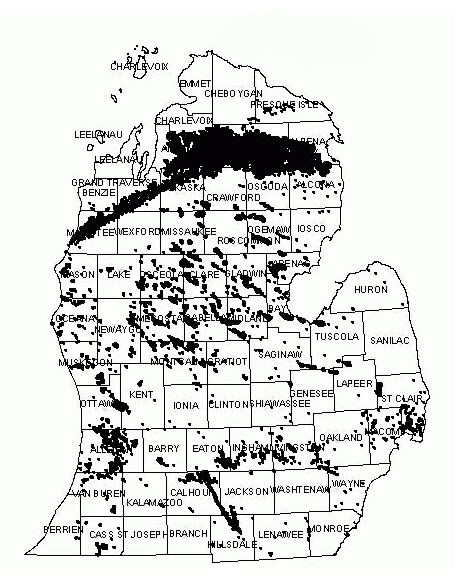Years of unsuccessful pursuit of oil in Michigan led Petroleum Magazine to give up on the state’s potential by 1920. “Oil Hunt In Michigan Is Hopeless – Oil projects in Michigan are but dreams which fail to materialize, in the opinion of those connected with the state geological survey, and that conclusion is base on its scientific research,” the trade magazine explained. Then, the 1928 discovery of the Mt. Pleasant oilfield suddenly enabled Michigan to become a significant oil producer – and attract new exploration companies. More oilfields would be discovered, including one in 1957 almost 30 miles long.
According to the Clarke Historical Library of Central Michigan University: Mt. Pleasant became a hub of Michigan petroleum activity, first as an accident of geology and later as a convenience of geography. The community lies close to the geographical center of the “mitten”, thus located equal distance from anywhere in the Lower Peninsula. Primary oil and gas explorationists, petroleum supply and service companies, geologists (and later geophysicists), drilling contractors all headquartered in Mt. Pleasant.
Similar to earlier oil booms in Texas, the 1928 Michigan oil well attracted new and often inexperienced companies. Among those seeking Michigan’s oil riches was Charles Van Keuren, who in 1933 established the Morris-Van Keuren Oil and Gas Syndicate. The 1902 graduate of Michigan University and former member of the Michigan House of Representatives had earlier been a partner in a Detroit securities investment firm.
Van Keuren’s syndicate spudded its first well on November 14, 1933, in Vernon Township of Isabella County on a 340-acre lease near the Ann Arbor Railroad. A cable-tool rig reached a total depth of 3,750 feet and the well was completed April 17, 1934, producing an “initial flow of 130 barrels per hour.” Three days later, the Clare Sentinel newspaper reported the Bowman Heirs No. 1 well was producing 3,000 barrels a day. Morris-Van Keuren Oil and Gas Syndicate planned three additional wells nearby to tap into the prospect.

Michigan oil and natural gas fields.
However, the syndicate’s Bowman Heirs No. 2 well proved to be a dry hole at 3,788 feet deep. When two additional wells left no indications of production, exploration efforts moved to the challenges of Michigan’s Upper Peninsula. Intermittently drilled since 1903, the “U.P” had never produced commercial quantities of oil.
“Recent rumors of a large ‘play’ to test the oil possibilities of the contact area of Michigan’s sedimentary and outcrop area in the upper peninsula took substantial form this week when it was announced that Charles Van Keuren, oil operator of this city, has leased lands of the Hiawatha Sportsmen’s club for oil prospecting,” noted the Republican-News and St. Ignace Enterprise on May 21, 1936.
The newspaper reported the syndicate had leased tracts comprising more than 26,000 acres covering most of Garfield township, Mackinac county, and extending into Pentland township in Luce county.
However, a 1937 lawsuit alleging “fraud in the sale of certain syndicate certificates” delayed drilling operations. The syndicate’s Hiawatha Club No. 1 well, drilled between August 15, 1936 and June 9, 1937, proved to be a dry hole at 1,500 feet. The well had reportedly “showed oil saturation in the Trenton and underlying formations, but did not develop into commercial production.”
Undeterred, the company soon began to drill a followup well. By August of 1938, the Detroit Free Press noted, “After a series of arduous labors, including the building of a road through virgin forest and swamp land and the clearing of a site in ‘cutover,’ Charles Van Keuren’s north land explorative campaign on the 12,000-acre Hiawatha Club tract in Mackinac County of the Upper Peninsula, is in the active drilling state.”
The new well was in Section 17, Township 44 North, Range 8 West. “The production possibilities are thought to be somewhat like those of the Texas Gulf Coast field, where similar geological conditions obtain,” one newspaper proclaimed. “The development of commercial production would substantially advance the expectancy of deep drilling to these stratas along the ‘highs’ now producing in the central part of the State.”
Two months later, the Escanaba Daily Press reported, “Oil Outlook Is Favorable – Trace Of Petroleum Is Found In Well In Mackinac County” and “Indications in Garfield township have proved so good that, in case the first Van Keuren well does not prove productive, others are likely to be drilled in the adjacent area.”
Despite the optimism, Morris-Van Keuren Oil and Gas Syndicate, like many to follow, did not find oil in Michigan’s Upper Peninsula. In 1939, the company undertook exchanges of Syndicate stock to support continued operations, but apparently to no avail. The Robert D. Fisher Manual of Valuable and Worthless Securities records Morris-Van Keuren Oil and Gas Syndicate No. 1 as dissolved on September 1, 1943. No commercial quantities of oil have ever been found on Michigan’s Upper Peninsula.
The largest Michigan oil and natural gas field was discovered in January 1957 on the dairy farm of Ferne Houseknecht. Her first oil well revealed Michigan’s golden gulch of oil that proved to be 29 miles long.
___________________________________________________________________________________
The stories of exploration and production companies joining petroleum booms (and avoiding busts) can be found updated in Is my Old Oil Stock worth Anything? The American Oil & Gas Historical Society preserves U.S. petroleum history. Please support this AOGHS.ORG energy education website. For membership information, contact bawells@aoghs.org. © 2018 Bruce A. Wells.

